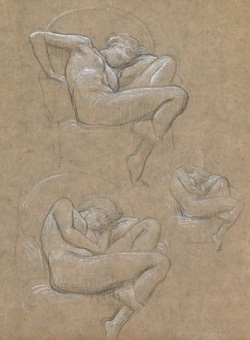How are you?
Currently, I am
introducing the stories about various artists and their paintings with the
title “Interesting
Art Stories”.
The 55th story is “Flaming June” by Frederic Leighton.
 |
| Self portrait, Frederic Leighton (1880) |
"Flaming June" is a painting by Frederic Leighton in 1895. This painting, with oil paints on a canvas of 120 × 120 cm, is widely considered as Leighton's masterpiece, showing his classicist nature.
The woman depicted in the painting seems to allude to
the figures of sleeping nymphs and naiads, often used as the subject of Greeks’
sculptures.
 |
| Hylas and the Nymphs, John William Waterhouse (1896) |
 |
| A Naiad, John William Waterhouse (1893) |
The painting disappeared in
the early 1900s and was rediscovered in the 1960s. The painting was auctioned
during Victorian era, but did not even sell for its minimum reserve price of
US$140 (about US$1,226 at modern prices). After the auction, however, it was purchased
by the Museo de Arte de Ponce in Ponce, Puerto Rico, which now owns the
painting.
 |
| The Museo de Arte de Ponce, Ponce, Puerto Rico |
The painting first started
as a motif for adorning a marble bathtub in one of Leighton's other works,
"Summer Slumber."
 |
| Summer Slumber, Frederic Leighton |
In this painting, Leighton
portrayed the allure of the sleeping woman in a way that seductively conveys to
the viewer. Her cheeks, tinged with blush, seems to suggest that she knows that
someone is watching her, even though she is sleeping.
While drawing this painting,
Leighton had a big trouble with the position of the sleeping woman, especially
for making the angle of her right arm look natural. Therefore, he made several
preliminary sketches before drawing this painting to confirm her pose. Also,
the toxic oleander branch in the top right of the painting seems to symbolize
the link between sleep and death.
 |
| Figure Studies for "Flaming June", pencil and white chalk on dark grey paper |
This painting became Leighton's most famous painting, and Samuel Courtauld, founder of the Courtauld Institute in London, England, described it as "the most wonderful painting in existence".
In this painting, Leighton expressed the realism of the
transparent clothing material worn by the sleeping woman and the marble
background strikingly perfect with rich colors, as with natural light, and also
expressed the sunset in her background to look like molten gold.
While the body of the woman in the painting remains a mystery, the face is believed to be either Dorothy Dene or Mary Lloyd, who were Leighton's two favorite models in the 1890s.
 |
| Cymon and Iphigenia, featuring Dorothy Dene, Frederic Leighton (1884) |
Mary
Lloyd, the daughter of an impoverished country squire, came to London and
established a very successful career as an artist’s model. She started modeling
for Leighton around 1892, and was asked to model for Leighton's
"Lachrymae.” It is also believed that she was the model for his
"Twixt Hope and Fear".
 |
| Lachrymae, Frederic Leighton (1894-95) |
 |
| Twixt hope and fear, Frederic Leighton (1895) |
Thank you.





No comments:
Post a Comment